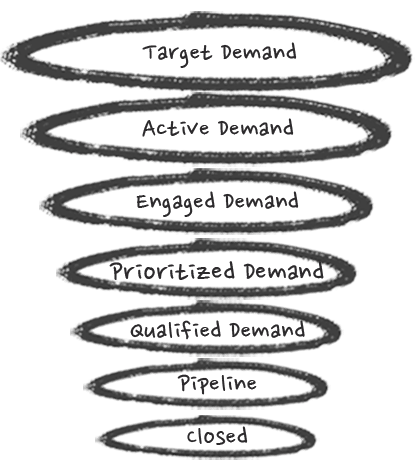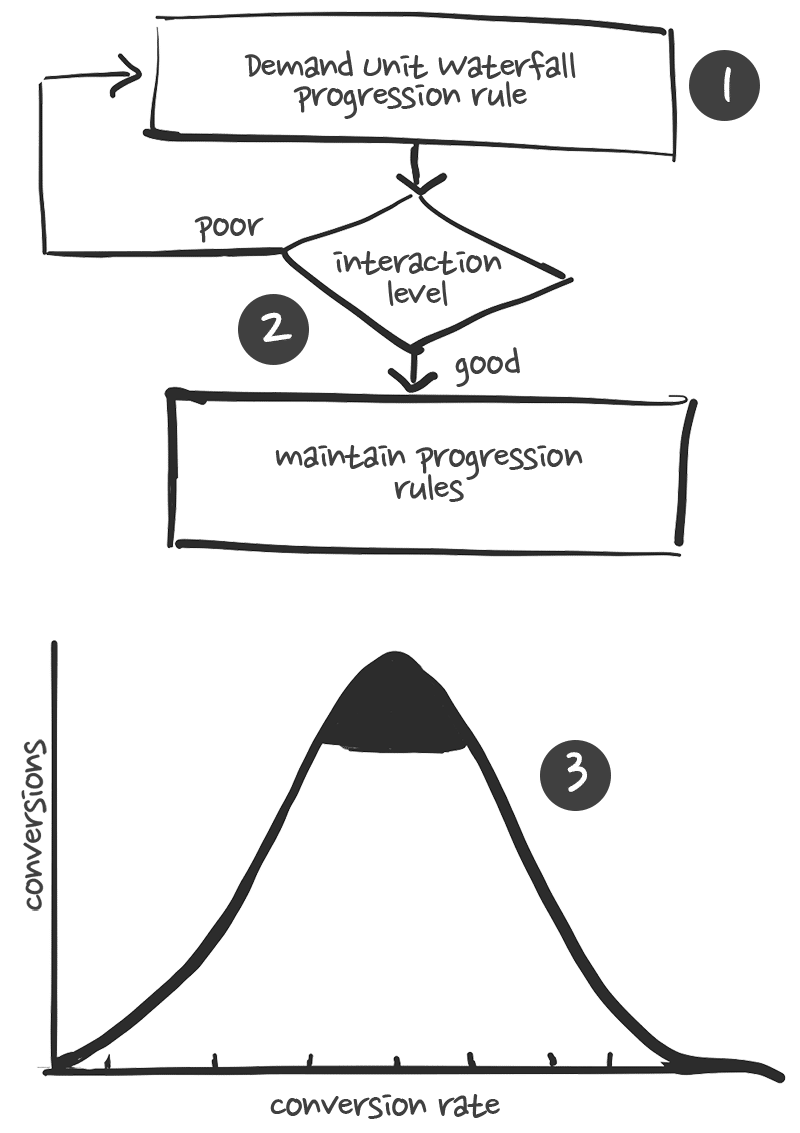Every once in a while you come across a concept that shifts your thinking in so many ways it becomes a new paradigm around which your world starts to turn. Epiphanies like this usually come in a clear, simple and obvious form. This is what the SiriusDecisions Demand Unit Waterfall represented to me when it was first introduced in May 2017. However, I didn’t really learn to fully appreciate it until I put it to work in my marketing practice. Only then did I realize how it could be used across so many areas. It has become the baseline around which all my strategic and tactical work revolves; my marketing Rosetta Stone.
I have used it as the basis to build marketing and sales technology stacks, go-to-market planning, buyer journeys, lead/account scoring, results measurement, and so much more. Even with the range of marketing funnels that are out there, the Demand Unit Waterfall stands out as the standard for B2B marketing, especially when companies adopt account-based marketing.
For those unfamiliar with the Demand Unit Waterfall, I will introduce it based on my experience of putting it to work in my own go-to-market practices. While I will detail what it is and how it works, this will mostly be a pragmatic view, not a theoretical one.
For those familiar with the Demand Unit Waterfall, I encourage you to continue to read this post to reacquaint yourself with the model and see it from a practitioner’s point-of-view.
I have a post for each stage of the Waterfall that goes into greater detail about how to integrate each one into your technology stack and go-to-market efforts, including links from the relevant sections throughout this post.
The Demand Unit

The core concept in the Demand Unit Waterfall is, unsurprisingly, a Demand Unit defined as a group of individuals in a target account that are stakeholders in the buying decision for your B2B product or service. It seems like such an obvious and simple concept. After all, we know that most B2B products and services, of any significance, have a set of stakeholders involved in the buying decision behind the scenes.
In the above illustration, there are 5 members of the Demand Unit:
- Your principal contact or “champion,” perhaps in this case a development lead.
- The IT director that will integrate the technology.
- The program manager managing the entire technology development effort.
- The CIO who will ensure the technology is the right fit from multiple perspectives.
- The purchasing manager that will ultimately negotiate the contract and its price.
Sales management certainly know about working the stakeholders in the buying process and constantly coach their sales staff to work accounts up, down, and across those accounts’ organizations.
Demand Units (not coincidentally) are the basis of Account-Based Marketing (ABM) as well. So none of this is news to B2B marketing. Or is it?
Lead vs account generation
In a world where B2B marketers focus on lead generation and are often measured by it, is marketing to a Demand Unit that obvious to us? And if so where does an account-based approach fit into a lead generation world?
Any B2B marketer is painfully familiar with the following scenario:
You are measured on lead volume, you deliver the leads you are committed to but sales won’t work them. You meet with sales to understand why they aren’t being worked and are told some variation of “because the leads suck, they are a waste of time.” Frustrated you then reply, “How do they suck? I have given you exactly what you asked for. If they suck, why aren’t you giving me feedback on how or why they suck so I can adjust my strategy?”
Perhaps the issue is our focus on lead generation itself? Yes, leads are essential; after all, you need to have a prospect to reach out to. But is it the most important thing? Also, is our focus on lead generation a distraction from what our focus should be: working the account not just the lead; working the “Demand Unit?”
When you sit down with sales management to introduce them to the Demand Unit Waterfall, explain how you are going to shift from lead gen to adopting the Demand Unit Waterfall as a basis for your marketing and sales support. If they appear confused because it is so obvious, take that as a sign you are more in alignment with them than you have ever been.
We are in the middle of a B2B marketing renaissance. In the past, the idea of marketing to Demand Units would have been mostly aspirational. With today’s incredibly rich set of tools and data to work with it no longer is. In many ways, lead generation was a function of the limits of the tools we had at our disposal. Now those limits are falling away.
The Demand Unit Waterfall

As is evident in the diagram above, the Demand Unit Waterfall has seven stages visualized as a funnel with each stage made up of a subset of accounts from the former stage. Marketers are all very familiar with this representation of a purchase funnel. Those of us that have been practitioners for some time understand that it is helpful, though not an accurate description of the purchase process. There is more to be said about this but for the purposes here, I would like to point out that accounts can, and do, enter the funnel at various stages, and may meander up-and-down the funnel. So think of this and any purchase funnel as an organizational principle, not a buyer’s journey.
Target Demand stage
Target Demand is where you determine the total addressable market of prospective accounts for your products and services. Target Demand should be used at more granular levels as well: to define the total addressable market for each product or service you offer, and for each marketing campaign.
The key to success in this stage is calculating the number of accounts in your total addressable market, as this is critical data for modeling campaign results and budgeting.
Target Demand stage in-depth
Determining the size and nature of your total addressable market as a whole and for each go-to-market campaign is the principal objective in the Target Demand stage.
Problems to avoid, preparing for success, tools you will need, your deliverables, team makeup, and critical KPIs are covered in this post as is a discussion on the power of predictive analytics.
Active Demand stage
Active Demand captures the number of accounts currently in-market. Few, if any, significant B2B purchases are impulse purchases. Prospects are often in the Active Demand stage for an extended period of time while they work to understand their needs better, evaluate the resource implications of purchasing a new product or service, drive alignment to the solution across their organization, calculate their ROI, buy vs. build vs. partner, and so on. The key to success at this stage is to know who is in the market at any given time.
Active Demand stage in-depth
Attracting, identifying and nurturing in-market accounts until you have determined that they are interested in the kind of products or services that your company sells is the principal objective in the Active Demand stage. If you are running or planning to run demand generation or awareness campaigns, this is the stage you would be doing that in.
Problems to avoid, preparing for success, tools you will need, your deliverables, team makeup, and critical KPIs are covered in this post.
Engaged Demand stage
In the Engaged Demand stage, the account starts interacting with your company or your company starts interacting with them.
The key to success in this stage is to drive deeper levels of engagement with one or (ideally) more members of the Demand Unit.
Engaged Demand stage in-depth
Nurture accounts along by driving deeper levels of engagement with the aim of validating that the account is moving into a product assessment phase is the principal objective in the Engaged Demand stage.
Problems to avoid, preparing for success, tools you will need, your deliverables, team makeup, and critical KPIs are covered in this post.
Prioritized Demand stage
In the Prioritized Demand stage, we determine whether the engagement level of the account has reached a threshold of interaction to justify turning the account over to the sales organization.
To be most effective in this stage you generally want to see engagement from the Demand Unit, not just a single individual. For this reason in this stage we should be account scoring, not lead scoring; the output is a marketing-qualified account, not a marketing-qualified lead. Although ideally, you do want at least one lead from the account for sales to follow-up with.See post on Implementing the Prioritized Demand stage including sections on stumbling blocks, preparing for success in this stage, tools, team makeup, deliverables, and measuring your success.
Prioritized Demand stage in-depth
Evaluating when an account has reached a threshold of engagement, indicating sufficient buying signals to warrant passing it to the sales team is the principal objective in the Prioritized Demand stage.
This is the rough equivalent to creating a marketing-qualified lead (MQL) through lead scoring but expanded from a lead to an entire account.
Problems to avoid, preparing for success, tools you will need, your deliverables, team makeup, and critical KPIs are covered in this post.
Qualified Demand stage
In the Qualified Demand stage, the account is handed over to the sales team to start working it, typically through email and outbound calling cadences. This is usually handled by a sales development or business development team but that will depend on how your company is structured and your internal account distribution rules.
The principal difference with prior methods goes back to the Demand Unit. At this stage sales (with the assistance of marketing) will be working the account as a Demand Unit; working the account at multiple levels based on the personas you have developed for the Demand Unit, as well as any research on the account that the salesperson has done. To achieve the best results it is essential to work the entire Demand Unit, not just a single “champion.”
Qualified Demand stage in-depth
Getting direct interaction with an account so we can understand their needs and determine what their budget, timeline, and authority to purchase is the principal objective in the Qualified Demand stage. This is generally done through a series of meetings or phone conversations between the sales team and the account, though it may be occasionally possible to validate by email.
Problems to avoid, preparing for success, tools you will need, your deliverables, team makeup, and critical KPIs for the Qualified Demand stage of the Demand Unit Waterfall are covered in this post.
Pipeline stage
Here the account moves into the sales pipeline and is progressed through it. Every company seems to have its unique flavor of pipeline stages, and I am not aware of any specific prescriptions for this in the Demand Unit Waterfall. However, as mentioned above in the Prioritized Demand stage, the key is for sales and marketing to target the entire Demand Unit, not just work the champion.
Pipeline stage in-depth
Moving accounts from an opportunity to close is the principal objective in the Pipeline stage is. This is best achieved through a direct interaction between sales and marketing, where marketing’s role is to provide the materials that prospects need to support their buying decision.
Problems to avoid, preparing for success, tools you will need, your deliverables, team makeup, and critical KPIs for the Pipeline stage of the Demand Unit Waterfall are covered in this post.
Closed stage
The account is closed-won or closed-lost and what you are looking to do here is learn from each. Understanding why accounts bought and why they did not buy will be invaluable feedback and input for your ongoing optimization efforts.
Closed stage in-depth
Understanding what is working and what is not throughout the Demand Unit Waterfall, and what that learning implies for the fine-tuning of your processes, messaging and collateral is the principal objective in the Closed stage.
Problems to avoid, preparing for success, tools you will need, your deliverables, team makeup, and critical KPIs for the Close stage of the Demand Unit Waterfall are covered in this post.
Account progression

Account progression diagram for account-based marketing – B2BOptimizer.com
In the Active, Engaged and Prioritized Demand stages, you will need to figure out what constitutes sufficient interaction with an account to push them down the Waterfall to the next stage. I use the method above to figure this out.
- Track to see how accounts perform in Active, Engaged and Prioritized Demand stages. If a high percentage of them do poorly, move them back up the Waterfall and set your progression rules tighter.
- If they perform well, maintain your progression rules.
- This begs the question: what defines good or bad performance? I believe the answer is in this graph. There is a sweet spot in the middle of the bell curve where you will generate the most number of accounts that convert/progress to the next stage. Set your progression rules too loosely and the percentage of accounts that progress will be low because those accounts were not yet ready. Set the rules too tightly and you will have too few conversions as you leave accounts that are real opportunities on the table.
As you will see in the more detailed posts about each of the stages in the Demand Unit Waterfall, there are no hard-and-fast rules about how to progress an account from one stage to the other. You want to look for signals at each stage that will tell you the account is ready to move to the next level, but the only way to know where you are on the bell curve is to test-and-optimize (like so much else in marketing) to find the rule set that optimizes output.
Furthermore, the progression need not be strictly linear down the Waterfall. For example, if an account you had never heard of enters your online chat and tells the agent they need to talk to a salesperson as they are evaluating competitors, you would probably send those off to sales in the Qualified Demand stage, essentially entering that account at that stage.
Accounts can, and do, get “stuck” or go dark at every stage in the Waterfall, and rules need to be set regarding what to do with them. Is 6 weeks long enough to keep an account in a specific stage, without any interaction, to determine they have gone dark? 3 months? 6 Months? And once you have the rules set for what defines an account that has gone dark, you will need to have rules about what to do with those accounts. For example, you might have a rule that puts the account back at the top of the Waterfall after 6 months to try again.
The implications
There are two critical requirements to adequately implementing the Demand Unit Waterfall:
- Your marketing efforts need to be directed holistically at target accounts. It is not enough to do lead generation. How widely it is directed at those accounts will be a function of how well-defined the Demand Unit is for your product and your specific targeting capabilities.
- The marketing team needs to own involvement with the account all the way to close. Throwing leads or accounts over the wall to sales and expecting optimal results isn’t realistic. It is critical to work with the sales team to understand the buyer’s journey and develop assets that can be used all along that path. With today’s remarketing and account-based advertising platforms you have the means at your disposal to market to accounts until closed.



